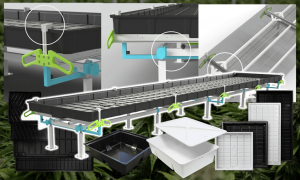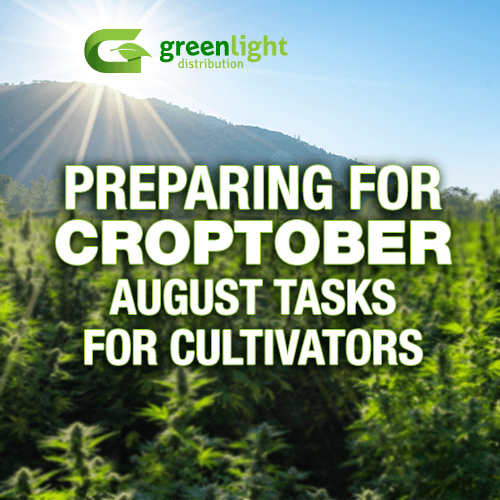As the warm summer days begin to wane and the sun starts setting a bit earlier each evening, cannabis cultivators around the world are gearing up for one of the most critical periods in their growing season: Croptober.
This term refers to the harvest season for outdoor cannabis plants, typically occurring in October. A successful Croptober can make all the difference in the quality and quantity of your cannabis yield. To ensure a bountiful and potent harvest, here are some important tasks cannabis cultivators should focus on during the month of August.
1. Pest and Disease Management:
August is a crucial time to keep a watchful eye on your plants for any signs of pests or diseases. As the weather changes, certain insects and pathogens become more active, potentially wreaking havoc on your crops. Regularly inspect your plants for any unusual spots, discoloration, or pest activity. Implement integrated pest management (IPM) techniques such as introducing beneficial insects, using neem oil or insecticidal soaps, and maintaining a clean growing environment.
2. Nutrient Management:
During the late stages of the vegetative phase and early flowering, your cannabis plants will have increased nutrient requirements. Monitor the nutrient levels in your soil or hydroponic system and adjust your feeding regimen accordingly. It’s important to strike the right balance between providing adequate nutrients and avoiding nutrient burn or overfeeding. As the plants transition into flowering, adjust the nutrient ratios to favor bloom-boosting elements like phosphorus and potassium.
3. Training and Pruning:
August is an opportune time to continue training and pruning your cannabis plants. Depending on your chosen cultivation technique, you might be employing methods like topping, super cropping, or using trellis nets to manage canopy height and promote even light distribution. Proper training can maximize light penetration, increase bud sites, and ultimately lead to higher yields.
4. Environmental Monitoring:
Maintaining optimal environmental conditions is crucial as your plants enter the flowering phase. Keep a close watch on temperature and humidity levels, especially as the weather starts to change. Outdoor growers may need to consider providing some form of shelter or protection against early cold snaps or excessive rainfall that could lead to mold and mildew issues.
5. Watering Practices:
As Croptober approaches, it’s important to refine your watering practices. Cannabis plants tend to require less water during the flowering phase compared to the vegetative stage. Adjust your watering schedule to prevent overwatering, which can lead to root rot and other problems. Be mindful of drainage, and consider using techniques like the “lift test” to gauge when your plants need watering.
6. Flush and Feeding Strategy:
Towards the end of August, it’s a good idea to start thinking about the final stages of your feeding strategy. Many growers opt for a pre-harvest flush to remove any accumulated salts and minerals from the soil, which can affect the taste and quality of the final product. Plan when and how you’ll initiate this process while still providing your plants with the necessary nutrients for healthy growth.
7. Harvest Planning:
While it may seem premature, it’s never too early to start planning for the harvest. Decide on the optimal time to begin harvesting your cannabis plants based on the strain’s flowering time and the desired cannabinoid and terpene profile. Gather your harvesting tools, such as trimming scissors and gloves, and set up a designated drying and curing space to ensure the best possible outcome.
In conclusion, August is a pivotal month for cannabis cultivators as they prepare for Croptober, the peak of the harvest season. By focusing on tasks such as pest management, nutrient adjustment, training, environmental monitoring, watering, and harvest planning, cultivators can set the stage for a successful and rewarding harvest.
A combination of careful planning, attention to detail, and the right cultivation practices can lead to a crop that’s not only abundant but also of exceptional quality. As the days grow shorter and the anticipation builds, cultivators can look forward to reaping the rewards of their hard work and dedication come Croptober.
Contact us for more information:

Maximize your growing space with a slide bench system
The Botanicare® Track Bench System is a game-changer for cannabis cultivators looking to elevate their operations to new heights.

Elevate Your Cannabis Cultivation with the new GAVITA RS 1900E LED grow light
The new GAVITA RS 1900E LED 208-480 V grow light from Greenlight Distribution emerges as a game-changer for cannabis cultivators.

Unveiling the Top 10 Trends in Cannabis Cultivation: February 2024 Edition
The experts at Greenlight Distribution have compiled our top ten trends in cannabis cultivation for 2024. Plus: action steps to take advantage of these trends.

What can cannabis cultivators do now for a successful 2024?
The new year is approaching quickly and smart business owners are prepared and ready to charge into 2024 with plans for success. Cannabis cultivators can prepare for The Year of the Dragon now and be ready to make the new year their most successful ever.
